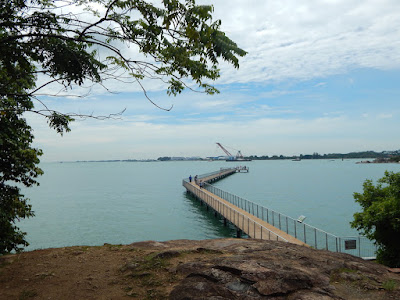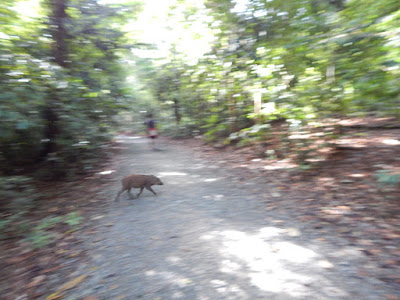We were delighted to have a group of 36 visitors join us for our monthly walk at Chek Jawa on 15 October.
If you have been to the top of Jejawi Tower at Chek Jawa, you will recognise this wonderful view of the island of Pulau Ubin. No tall buildings, no concrete, no highways. Just rich vegetation and forests that provide a safe haven for the amazing plant and fauna biodiversity. This is our precious Pulau Ubin!
And this is the other view. There's the Chek Jawa coastal forest (on a hillock) in foreground on the right, part of the outer mangroves on the left, a view of Pulau Tekong (the biggest island belonging to Singapore) in the horizon, and beyond that a glimpse of the Malaysian state of Johor.
This is the happy group of visitors at the start of our walk. So glad to see a bigger turnout this month, after the initial fears and uncertainty about the Zika cases in September.
The wild boars greeted us when we arrived at Chek Jawa. We were slightly worried to see just the mummy wild boar and a little one. What has happened to the other piglets? Hope they are alright.
Here's a closeup photo of the nipah palm flowers. The female flower is in the centre, and 2 male inflorescence by the sides. Can you see the beautiful bees and flies in the photo? These insects serve the very important role of pollinators in the web of life.
In the forest near the Information Centre, we saw a huge fast-flying dragonfly. Ria managed to capture a photo of it, posted a photo on Facebook, and asked for help to identify it. It turned out to be a Anax guttatus, also commonly known as Hairy Emperor Dragonfly.
 |
| Photo credit: Ria Tan |
Can you see another common resident of the mangroves? Look for the large beady eyes. Yes, that's right, you're looking at the Giant Mudskipper with its head sticking out above the water. This is the largest of the mudskippers found in Singapore.
Here's an excellent drawing of a mudskipper by a visitor.
We are lucky to see the Spotted green pufferfish in the mangroves three months in a row. It is a beautiful fish with yellowish-green back and black spots. Come to Chek Jawa to admire the pufferfishes.
 |
| Photo of a mangrove pufferfish taken in September |
Leah, age 10, has drawn a picture of the cute pufferfish that she saw during the walk. Excellent documentation, Leah!
We forgot to take a photo of the Tree-climbing crabs, but here's a drawing of a crab in its mud mound by Peta, age 6.
With the tide at around 3 metres, the back mangroves was full of life. We don't normally see a Striated Heron this close. This little fellow was so focussed on stalking its prey in the water that it did not seem to be aware of us.
See how the incoming tide affects the animals in a mangrove. These snails have crawled up to a higher level to get out of the way of rising water. It is fascinating that the snails seem to know the tide was coming in and so they crawled up even before the tide reaches them. How on earth do they know?
As we followed the bend of the boardwalk, we finally reached the outer mangroves where the trees are taller and the stilt roots are more spectacular. Here is Tim explaining how the mangroves break up the energy of an incoming tide, allowing marine animals to find refuge in the waters.
The beautiful mangroves. In many parts of the world, government and municipal leaders have come to realise the importance of conserving (and planting) mangroves to protect shorelines from erosion, protection of valuable nursery areas for fish and invertebrates, to store the carbon in the rich soils, and to protect endangered and threatened species living in mangrove habitats.
I am always fascinated by the hanging roots of the tall mangrove trees. These are prop roots that grow out of tall branches and will eventually reach the ground to provide additional support for the growing tree. Mangroves are excellent adapters to the harsh environment that they are found in.
Most visitors would miss this sighting, but the experienced guides are able to point out the mudskippers on the mangrove roots if the tide is high. Don't you think the mudskipper is cute? It is a fish, yet this fish wants to get out of water when the tide is high. Nature is strange and wonderful all at once! I am going to ask you to take a closer look at the photo and see those orange spots on its cheeks and belly. This is the Gold-spotted mudskipper.
This is the scenic view on the coastal boardwalk. Enjoy the views!
The Chek Jawa coastal forest is to your right as you walk on the boardwalk.
It was a beautiful glorious day.
There are two beacons in Chek Jawa, although we tend to notice only the one standing in the water. There is a second beacon located at the back of the coastal forest. This is the Chek Jawa Rear Beacon. In the days before GPS, ship captains will visually check the locations of the two beacons as they navigate their ships through the narrow straits. The guides explained this to the visitors, and see what one kid produced in his drawing?
The kid listened to our story and then drew the imaginary straight line formed by the Front and Rear Beacons of Chek Jawa at the end of the tour. This truly makes our day!
Enjoy the rest of the photos and drawings.
 |
| English Cottage, also known as House Number One, Pulau Ubin |
 |
| Private jetty of the English Cottage |
 |
| Same jetty re-produced in a drawing |
Some photos of our volunteer guides at work...
 |
| Pei Yan and her group |
 |
| Juhari, |
 |
| Sumita and Tim with their group of visitors |
 |
| Words from a young visitor, age 12 |
As always, thanks go out to our volunteers: Juhari, LK, Ivan, Ria, Sumita, Tim and PeiYan.
 |
| Photo credit: Mohammad Juhari |
Our next walk is on 19 November, 2016, and registration is open at our Online Registration Form. Come and see the wonderful mangrove and coastal biodiversity of Chek Jawa with us.




















No comments:
Post a Comment